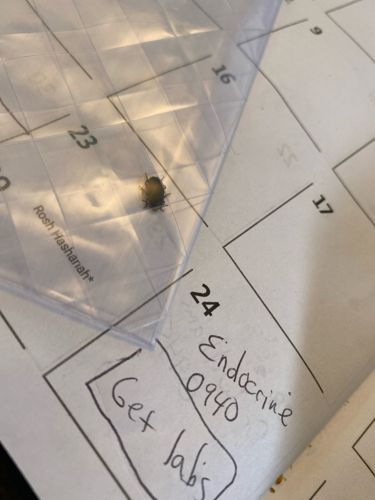Carpet Beetle (likely Varied Carpet Beetle or Black Carpet Beetle)
Scientific Name: Likely *Anthrenus verbasci* (Varied Carpet Beetle) or *Attagenus unicolor* (Black Carpet Beetle), but could be another species within Dermestidae.
Order & Family: Order: Coleoptera, Family: Dermestidae
Size: Adults typically range from 2 to 5 mm (0.08 to 0.2 inches) in length. Larvae can be slightly larger, up to 6 mm.

Natural Habitat
Indoors, carpet beetles are found in homes, museums, warehouses, and other structures. They commonly inhabit carpets, rugs, upholstered furniture, closets, attics, and areas where lint, pet hair, or food crumbs accumulate. Outdoors, adults can be found on flowering plants.
Diet & Feeding
Larvae of carpet beetles are scavengers that feed on a wide range of animal and plant products. This includes wool, silk, feathers, leather, furs, pet hair, dead insects, museum specimens, cereals, and other dried food products. Adult carpet beetles feed on pollen and nectar, frequently found outdoors on flowers.
Behavior Patterns
Carpet beetle larvae are typically found in dark, undisturbed areas where food sources are plentiful. They avoid light and tend to move slowly. Adults are attracted to light and often found near windows. The larvae are the damaging stage, feeding on various organic materials. They undergo complete metamorphosis with eggs, larvae, pupae, and adult stages. The life cycle can take anywhere from two months to over a year, depending on environmental conditions and food availability. Adult females lay eggs on suitable larval food sources.
Risks & Benefits
Risks: Carpet beetles are significant household and museum pests. Their larvae can cause considerable damage to natural fibers (wool, silk, fur, feathers), upholstered furniture, carpets, clothing, and stored food products. Some people may develop allergic reactions or skin irritations (dermatitis) from contact with larval hairs or shed skins, although they do not bite or sting. Benefits: In their natural outdoor habitat, they act as decomposers, helping to break down organic matter like dead insects and animal remains. However, their beneficial role is greatly outweighed by their pest status in human environments.
Identified on: 8/28/2025